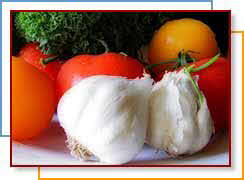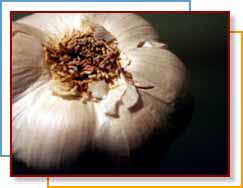Home | FOOD ARTICLES | Food Trivia | Today_in_Food_History | Food_History_Timeline | Recipes | Cooking_Tips | Food_Videos | Food_Quotes | Who’s_Who | Culinary_Schools_&_Tours | Food_Trivia_Quizzes | Food_Poems | Free_Magazines | Food_Festivals_and_Events
Food Articles, News & Features Section
You are here > Home > Food Articles >
FREE Magazines
and other Publications
Free Professional and Technical Research, White Papers, Case Studies, Magazines, and eBooks
GARLIC: Varieties, Selection & Preparation
See Also: Article 2 on Garlic - Vampire Repellent - Garlic Quotes
Garlic Trivia - Kitchen Tips
 For years garlic has been the topic of much folklore. In ancient times, its pungent odor was believed to supply strength and courage to those who ate it. Garlic has been used for numerous things including embalming, warding off evil spirits, and curing everything from the common cold to tuberculosis and broken bones.
For years garlic has been the topic of much folklore. In ancient times, its pungent odor was believed to supply strength and courage to those who ate it. Garlic has been used for numerous things including embalming, warding off evil spirits, and curing everything from the common cold to tuberculosis and broken bones.
Even in modern times, garlic is still being promoted as a health food with medicinal properties. Though garlic is a nutritious food, many of the claims surrounding it are not backed up by research
Garlic is a member of the Allium genus and classified as Allium sativa. The garlic bulb is covered with a loose, white, crackly outer skin and comprised of individual sections called cloves. Each clove is covered in a white sheath.

Garlic is very popular in the Middle East and Mediterranean countries, India and China. In America, 250 million pounds of garlic are consumed per year and its use is growing.
Garlic is characterized by it’s strong flavor and smell, stemming from its sulfur compounds. It makes a great flavoring agent for a variety of dishes.
Varieties
There are approximately 300 varieties of garlic grown throughout the world. In the United States about 90% of the garlic is grown in California and most comes in two types, early and late.
Early garlic is white or off-white in color and harvested in mid-summer. Late garlic is off-white on the outside
American: white-skinned with a strong flavor.
Chileno: a reddish-colored, sharp tasting garlic grown in Mexico
Elephant: Not a true garlic, but a relative of the leek; its flavor is very mild and it is characterized by larger heads.
Green Garlic: Young garlic before it starts forming cloves. Green garlic looks like a baby leek with a long green top and small white bulb. Its flavor is much more mild than that of mature garlic.
Italian: Mauve in color with a somewhat milder flavor.
Availability, Selection, and Storage

Garlic is available year-round frozen or fresh. When buying fresh garlic, choose from plump, dry heads that feel firm. Avoid soft, mushy or shriveled cloves. American garlic should be white to off-white. Garlic should be stored in a cool, dark place (though not a refrigerator) and can be kept for several weeks. Many people use small clay garlic holders to keep their garlic as fresh as possible. Cloves that have sprouted can still be used but they will not be as strong in flavor as fresher cloves. The sprouts themselves can be cut up like scallions and chives and used in dishes.
Preparation
To remove individual garlic cloves, peel outer layers from the bulb and snap out each clove from the base. Cloves can than be peeled very easily. For a more mild flavor, whole cloves can be added (unpeeled for an even more subtle taste) to food while it cooks or marinates and than discarded before serving the meal. Another trick for imparting a mild garlic flavor in your dish is to spear a garlic clove with a fork and stir your dish with it — discarding the garlic when stirring is complete.
For a stronger flavor, used chopped, crushed, pressed or pureed garlic in dishes. The more finely garlic is chopped, the stronger its flavor will be. To chop garlic, cut in half lengthwise (remove the green core if there is one — it is bitter). Make several lengthwise cuts and than cut crosswise. A garlic press can be used also though these can be a bit tricky to clean.
To remove garlic odor from hands, use salt or lemon juice and than wash your hands with soap.
Cooking Garlic
Cooking garlic decreases the strength of its flavor making it much milder. The longer it is cooked, the more mild it tastes. Be careful not to sauté garlic too long at too high a temperature, it will brown very quickly and can become bitter.
To bake garlic, place whole, unpeeled bulbs rounded side down in a shallow baking dish, drizzle with oil, cover with foil and bake for 1 1/2 hours at 325ºF.
Add garlic to spice up your 5 to 9 A Day Plan!
- Flavor soups and stews.
- Roast with meats or poultry.
- Chop finely for salad dressings.
- Bake whole heads until softened; pop out soft flesh from cloves and spread on bread.
- Put minced garlic on a loaf of bread to make an authentic tasting garlic bread!
RELATED ARTICLES
Please feel free to link to any pages of FoodReference.com from your website.
For permission to use any of this content please E-mail: james@foodreference.com
All contents are copyright © 1990 - 2025 James T. Ehler and www.FoodReference.com unless otherwise noted. All rights reserved.
You may copy and use portions of this website for non-commercial, personal use only.
Any other use of these materials without prior written authorization is not very nice and violates the copyright.
Please take the time to request permission.

